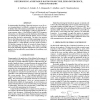Free Online Productivity Tools
i2Speak
i2Symbol
i2OCR
iTex2Img
iWeb2Print
iWeb2Shot
i2Type
iPdf2Split
iPdf2Merge
i2Bopomofo
i2Arabic
i2Style
i2Image
i2PDF
iLatex2Rtf
Sci2ools
ICIP
2006
IEEE
2006
IEEE
Determining Achievable Rates for Secure, Zero Divergence, Steganography
In steganography (the hiding of data into innocuous covers for secret communication) it is difficult to estimate how much data can be hidden while still remaining undetectable. To measure the inherent detectability of steganography, Cachin [1] suggested the secure measure, where is the Kullback Leibler (K-L) divergence between the cover distribution and the distribution after hiding. At zero divergence, an optimal statistical detector can do no better than guessing; the data is undetectable. The hider's key question then is, what hiding rate can be used while maintaining zero divergence? Though work has been done on the theoretical capacity of steganography, it is often difficult to use these results in practice. We therefore examine the limits of a practical scheme known to allow embedding with zero-divergence. This scheme is independent of the embedding algorithm and therefore can be generically applied to find an achievable secure hiding rate for arbitrary cover distributions....
Arbitrary Cover Distributions | ICIP 2006 | Image Processing | Inherent Detectability | Optimal Statistical Detector | Secure Hiding Rate | Secure Measure |
| Added | 22 Oct 2009 |
| Updated | 22 Oct 2009 |
| Type | Conference |
| Year | 2006 |
| Where | ICIP |
| Authors | Kenneth Sullivan, Kaushal Solanki, B. S. Manjunath, Upamanyu Madhow, Shivkumar Chandrasekaran |
Comments (0)

